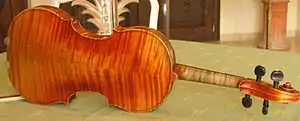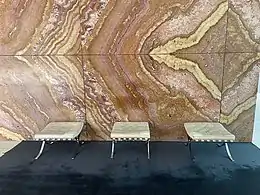Bookmatching
Bookmatching is the practice of matching two (or more) wood or stone surfaces, so that two adjoining surfaces mirror each other, giving the impression of an opened book.[1]

As applied to wood, bookmatching is usually done with veneer (produced in one of several ways), but can also be done with solid wood. The technique is used to beautify a variety of objects such as furniture, violins, guitars[2] or the interior of high-luxury cars. The two adjoining surfaces are produced from the same piece of wood, so that they have (almost) exactly the same appearance, but mirrored.[3] The final effect varies with the figure of the wood chosen[4] and can range from extremely subtle (so that the two surfaces almost appear to be a single piece of wood), to dramatic effects with wavy grain showcased, as in high-end guitars.[5]
Bookmatching is also possible with marble or other patterned stone.[6][7]

See also
- Luthier
- For keyboard instruments adorned with bookmatched veneer, see Spinet and Conrad Graf.
References
- "5 things you should know about bookmatching stone". Pacific Shore Stones. 2016-04-11. Retrieved 2019-05-23.
- Woodworks, Westfarthing (2017-03-10). "Bookmatching the Plates – Guitar Making Tip". Westfarthing Woodworks. Retrieved 2019-05-23.
- "The Art of Bookmatching". David Scott. 2016-06-07. Retrieved 2019-05-23.
- "Make Book-Matched Panels | Band Saw | Resaw | Woodworking". Woodworking | Blog | Videos | Plans | How To. 2015-01-01. Retrieved 2019-05-23.
- "The Short Story on Book-Matched Panels". WOOD Magazine. 2016-06-10. Retrieved 2019-05-23.
- "Global Granite & Marble :: FAQ". Archived from the original on 2014-11-15. Retrieved 2014-07-01.
- "The Art of Bookmatching". David Scott. 2016-06-07. Retrieved 2019-05-23.